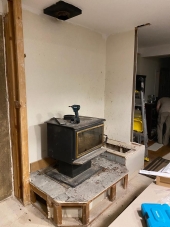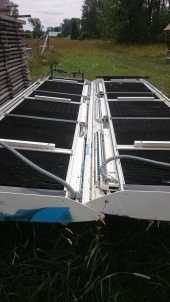




 2
2




Iterations are fine, we don't have to be perfect
My 2nd Location:Florida HardinessZone:10 AHS:10 GDD:8500 Rainfall:2in/mth winter, 8in/mth summer, Soil:Sand pH8 Flat
 2
2




Graham Chiu wrote:My wood burner presumably isn't that great at capturing all the heat from the burn as I've measured the flue temperature at over 230 degrees Celsius. Now I've seen people wrap copper coils around their flues to heat a water container, and that's not feasible where my stove is. However, is there any reason one can't use such a coil to provide instant hot water? Just pour in cold at the top and extract hot at the bottom? Or even let it drip into coffee grounds?
Also, why is copper always used? Is there better heat transfer to copper vs stainless steel?





SKIP books, get 'em while they're hot!!! Skills to Inherit Property




Graham Chiu wrote:Also, why is copper always used? Is there better heat transfer to copper vs stainless steel?
S Bengi wrote:Yes copper is better than steel at transferring heat.




Mike Jay wrote:
Here's the idea. If the water is trickling down a hot surface, it will heat up. If your coil of copper is 1" diameter and very short (12") and you pour water down it slowly, there is a lot of room in the pipe for steam (if it happens) to escape. If your coil was the equivalent of a small copper gutter that coils around the pipe, it's even more open to the air. Any boiling is uneventful.
Mike Jay wrote:
If you patent it and get rich, send me some $




Matt Coston wrote:
Copper is also very malleable so it's easy to bend into coils.
Matt Coston wrote:
My concern with copper is that, if you look around a typical home, you rarely ever see drinking water being heated or stored in copper vessels. Washing water is often heated and stored in copper, but not drinking water. Makes me wonder if there is some health issue.




Our inability to change everything should not stop us from changing what we can.




Graham Chiu wrote:But there is this http://www.health.state.mn.us/divs/eh/water/factsheet/com/copper.html
In addition, hot water dissolves copper more quickly than cold water; as a result, water to be used for drinking or cooking should not be drawn from the hot water tap.
 3
3




Matt Coston wrote:
Graham Chiu wrote:But there is this http://www.health.state.mn.us/divs/eh/water/factsheet/com/copper.html
Thank you for the link. However, there's this import part lurking at the end:
In addition, hot water dissolves copper more quickly than cold water; as a result, water to be used for drinking or cooking should not be drawn from the hot water tap.
Not sure if this statement is true in isolation. Earlier in the article it says copper pipes in new homes have not yet developed the "coating" (I assume this is copper oxide) to stop leeching into the water. The article doesn't explicitly state if hot water from old copper pipes is safe.
I was taught that the reason we don't drink the hot water from a kitchen tap is because the hot water tank is not hygienic. Maybe both are true.









SKIP books, get 'em while they're hot!!! Skills to Inherit Property





Our inability to change everything should not stop us from changing what we can.




Trace Oswald wrote:I was told that people used to teach not to drink from the hot water because "back in the day", lead pipes were sometimes used for water and hot water made more lead in the water.
Mike Jay wrote:If so, are you supposed to make soup starting with cold water?
Mike Jay wrote:Copper pots, tureens and other copper cookware would be suspect as well.




Mike Jay wrote:
I'm thinking we're getting away from the original subject...
A build too cool to miss:Mike's GreenhouseA great example:Joseph's Garden
All the soil info you'll ever need:
Redhawk's excellent soil-building series










Our inability to change everything should not stop us from changing what we can.




 2
2




"The only thing...more expensive than education is ignorance."~Ben Franklin
"We can easily forgive a child who is afraid of the dark; the real tragedy of life is when men are afraid of the light." ~ Plato





 2
2




Our inability to change everything should not stop us from changing what we can.









Our inability to change everything should not stop us from changing what we can.








Travis Johnson wrote:Most woodstoves are only 50% effecient, BUT because the cost of fuel is so low, it makes it an overall better use of fuels then anything else, like say a propane heater to heat a home. Firewood is cheaper then propane, so wasting 50% of it is not a big deal.

I do however refute the claims that tankless water heaters are more effecient; that depends on the size of the household. I have a family of (6), with 5 being women. That means we consume a lot of hot water in a day, so after reviewing my options, it was determined that I would save more money by having a tank type heater then tankless. That is because while a tankless does not have to keep a tank of water hot 24/7, it takes a lot of BTU's (fuel consumption) to make instant hot water. Effeciency also comes from how far the unit is from sinks, showers, appliances, etc. So it is not clear cut. It really depends on teh application.





Our inability to change everything should not stop us from changing what we can.





Our inability to change everything should not stop us from changing what we can.









Our inability to change everything should not stop us from changing what we can.




 I can gradually test it as the flue temperature rises. Full protection of course.
I can gradually test it as the flue temperature rises. Full protection of course.




Our inability to change everything should not stop us from changing what we can.


















Our inability to change everything should not stop us from changing what we can.












Matthew Goheen wrote:I am particularly fond of the idea of having a copper coil heat exchanger suspended in an open top water tank that is the heat limiter, and “ballast” mass, sitting atop a masonry walled bell, with insulation on the outside of the bell and an openable insulated cover over the top of the tank. The large volume of water in the tank becomes a significant portion of your mass, with the masonry storing additional heat..
 2
2




Greg Mamishian wrote:Here's a way to bend tight small radius copper coils without kinking the tubing.




Graham Chiu wrote:
So this is a copper pipe closed at both ends that is exposed to the heat source, and just lying like a kettle stainless steel heating coil? Like an electric hot water cylinder minus the insulation?




Graham Chiu wrote:I picked up a 1 m length of 15 mm copper pipe. I'm going to heat it to 250 deg C in a fire and quench it in cold water to see what happens.

|
There will be plenty of time to discuss your objections when and if you return. The cargo is this tiny ad:
GAMCOD 2025: 200 square feet; Zero degrees F or colder; calories cheap and easy
https://permies.com/wiki/270034/GAMCOD-square-feet-degrees-colder
|




